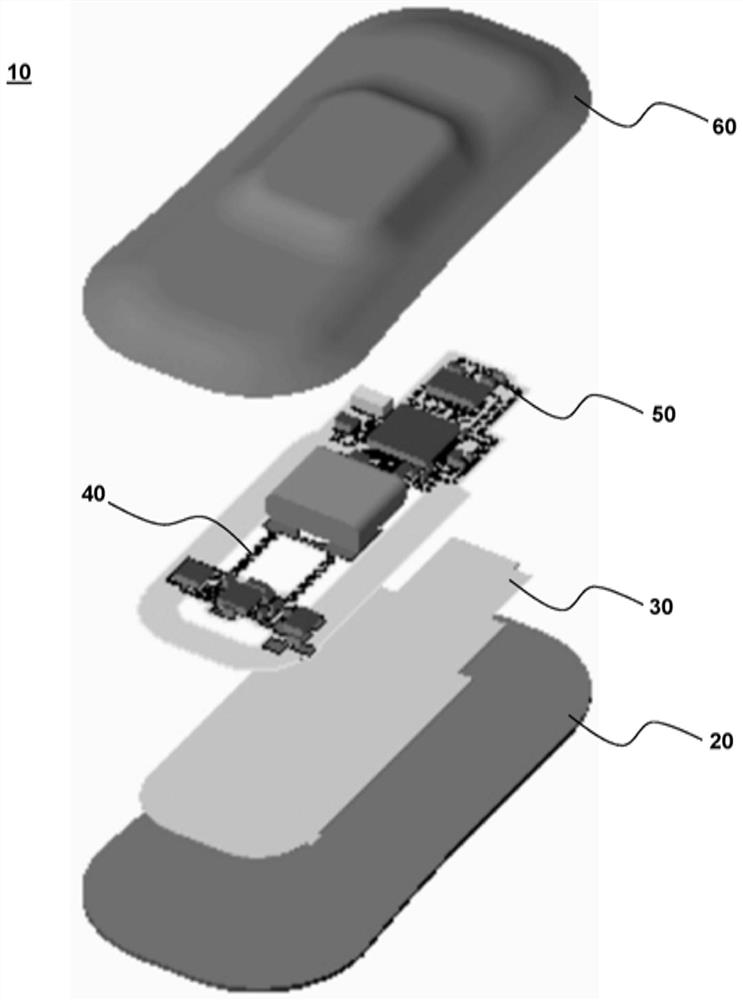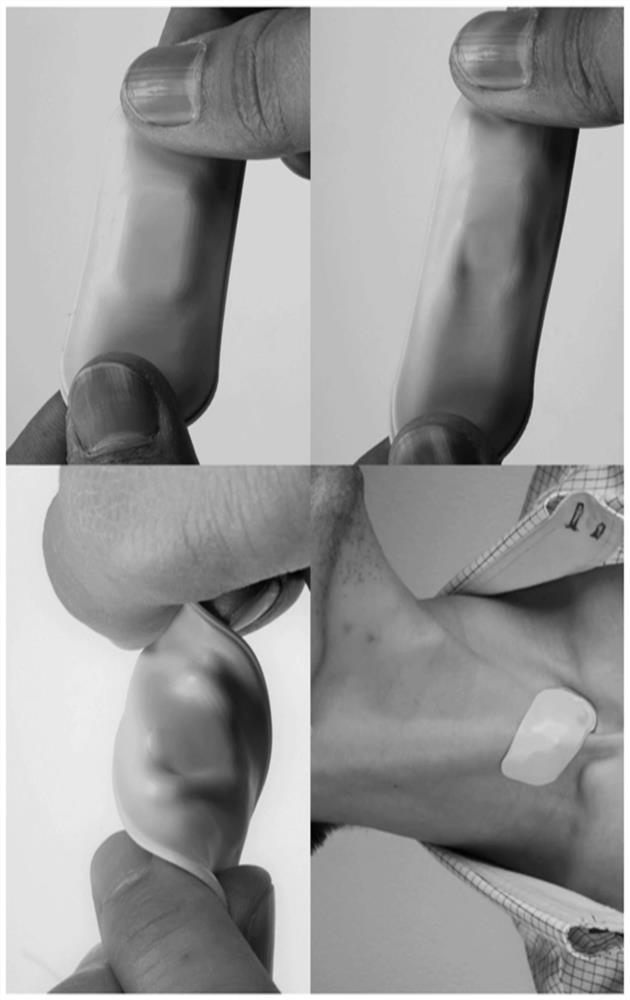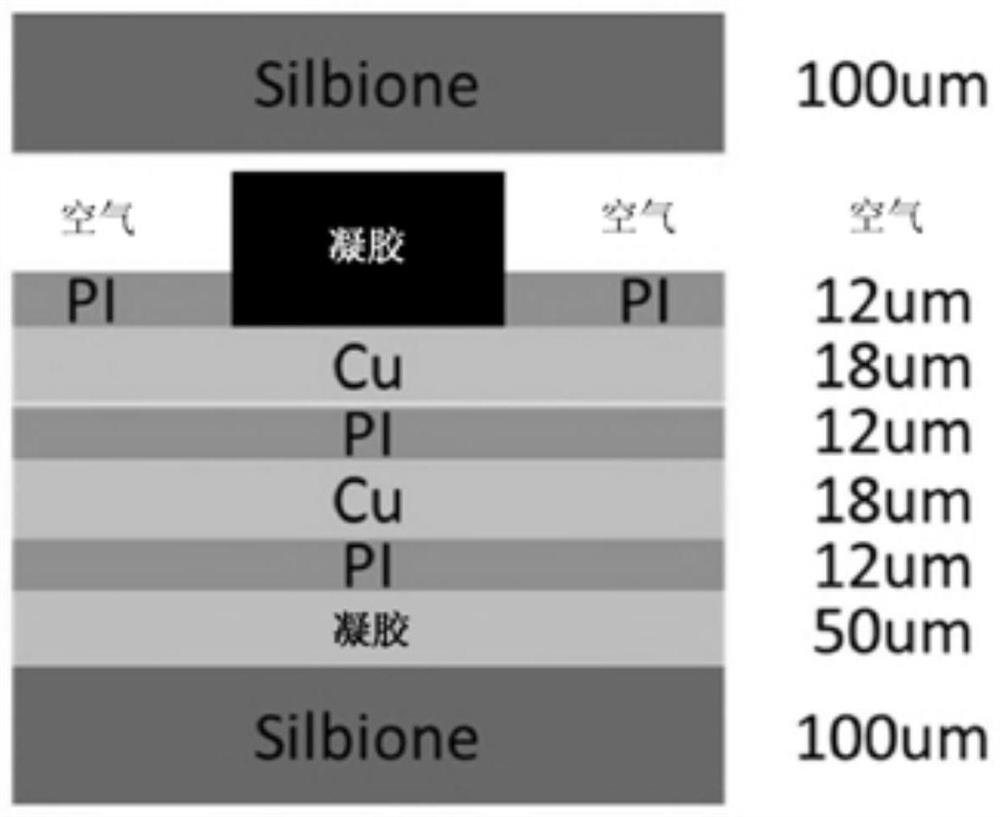Wireless medical sensors and methods
A sensor, wireless power technology, applied in the field of wireless medical sensors and methods, can solve the problems that prevent the practicality of wearable devices, skin acoustic impedance mismatch, mass density, mass density and modulus, etc., to improve overall health and well-being Effect
- Summary
- Abstract
- Description
- Claims
- Application Information
AI Technical Summary
Problems solved by technology
Method used
Image
Examples
example 1
[0243] Example 1: Exemplary epidermal device employing mechano-acoustic sensing and actuation
[0244] Exemplary devices employing mechano-acoustic sensing and actuation were fabricated and tested with respect to overall functionality and mechanical properties.
[0245] Figure 43B An exploded view of the mechano-acoustic device of the present invention for skin sensing and actuation is provided. As shown, the mechano-acoustic sensor is encapsulated in a silicone elastomer substrate and the cover (eg, cover) assembly includes a silicone gel layer to provide an overall multilayer floating device architecture. As shown, the multilayer device includes an IC assembly, a power source (e.g., a battery), traces containing contacts and interconnection components (e.g., flexible serpentine interconnects and contact pads), and spacers (e.g., polyamide imine layer). The multilayer architecture and device components are arranged to allow effective integration with the subject's tissu...
example 2
[0250] Example 2: Wearable Sensors for Early Triage of Newborns at High Risk of CP
[0251] The present examples demonstrate the effectiveness of the flexible wearable sensor device of the present invention for diagnostic applications including early triage of neonatal subjects at high risk of having cerebral palsy (CP). Prediction of final neurological function in at-risk neonates is challenging, and studies have demonstrated that the absence of restless movement is predictive of CP development (see eg, BMJ2018:360:K207). CP assessment of neonatal subjects is typically performed by a general mobility assessment (GMA) (eg, corresponding to a 5-minute video assessment of a supine infant with a standardized scale).
[0252] In some embodiments, networked sensors provide additional value. The ability to assess limb movement synchronously in time through a network of on-body sensors will allow for greater insight into abnormal movement. Similar to sleep, this would allow visua...
example 3
[0262] Example 3: Mechano-Acoustic Sensing
[0263] Summary
[0264] Conventional multimodal biosensing requires multiple rigid sensors installed on multiple measurement sites at a given location and during a reserved time. Soft and conformal devices utilizing MEMS accelerometers change this tradition. It is suitable for recording mechano-acoustic signals originating from human physiological activities in a continuous wearable mode of operation. Advantages of the device (including the multiplexed sensing function) established continuous recording of subtle vibrations in the range of skin (approximately 5 × 10 -3 m·s -2 ) to the larger inertial amplitude of the body (about 20m·s -2 ) and a new opportunity space for hi-fi signals on the skin from static gravity to the 800Hz audio band. The minimal space and time constraints of the device operating outside of the clinical setting will magnify the benefits of the unusual mechanics of the electronics. Therefore, a system-le...
PUM
 Login to View More
Login to View More Abstract
Description
Claims
Application Information
 Login to View More
Login to View More - R&D
- Intellectual Property
- Life Sciences
- Materials
- Tech Scout
- Unparalleled Data Quality
- Higher Quality Content
- 60% Fewer Hallucinations
Browse by: Latest US Patents, China's latest patents, Technical Efficacy Thesaurus, Application Domain, Technology Topic, Popular Technical Reports.
© 2025 PatSnap. All rights reserved.Legal|Privacy policy|Modern Slavery Act Transparency Statement|Sitemap|About US| Contact US: help@patsnap.com



